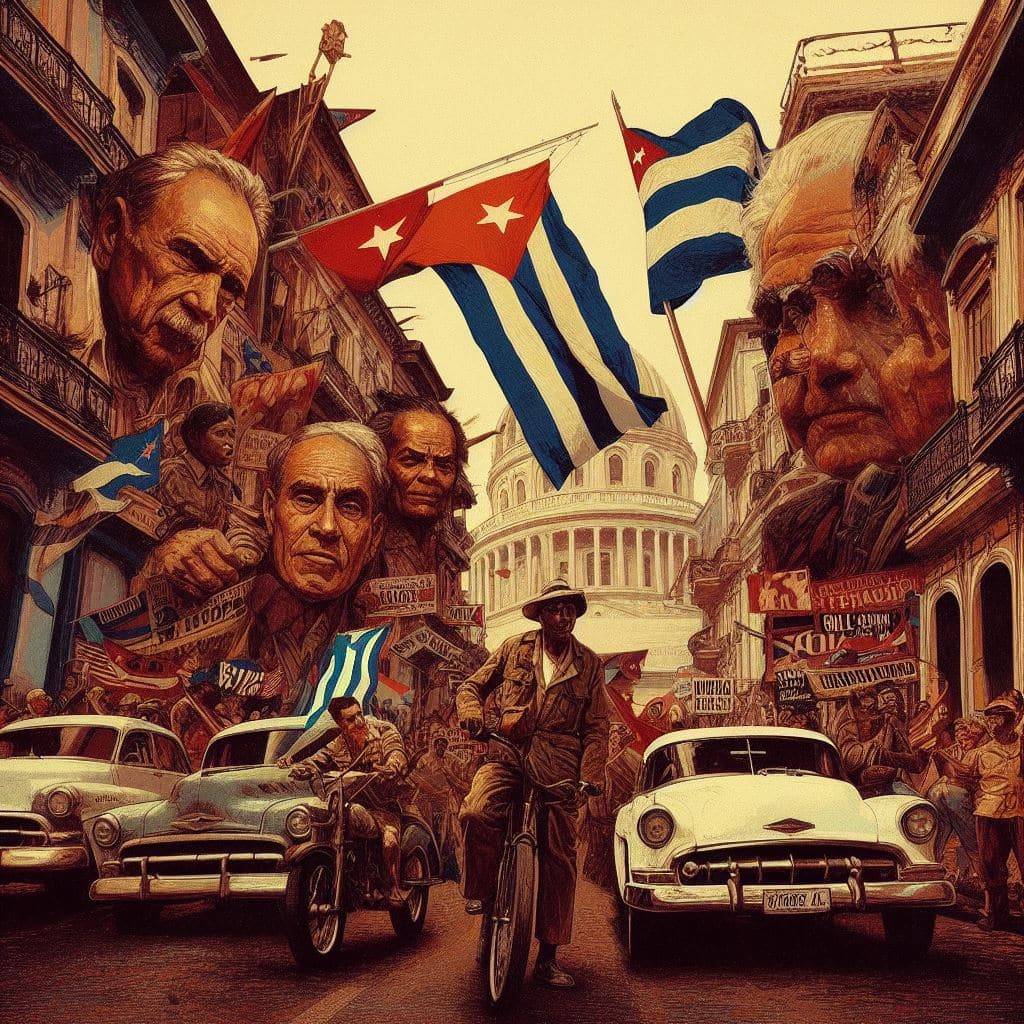The article “Operation Pedro Pan” delves into a significant yet lesser-known chapter of Cold War history, shedding light on a U.S.-backed initiative that led to the exodus of nearly 14,000 unaccompanied Cuban children to American shores.
As tensions between the U.S. and Cuba escalated during the early 1960s, fears of communist indoctrination and the potential loss of parental rights prompted many Cuban parents to make the heart-wrenching decision to send their children to the U.S., hoping for a safer and freer future for them.

This operation, known as Operation Pedro Pan, stands as a testament to the lengths families will go to protect their children, set against the backdrop of geopolitical power struggles and ideological warfare.
The program, while rooted in a desire to safeguard the future of these children, also became entangled in the broader political machinations of the era, making it a complex and multifaceted historical event.
Operation Pedro Pan Answers
| Question | Answer |
|---|---|
| The Article primarily discusses _________. | a U.S.-backed program that resulted in nearly 14,000 unaccompanied Cuban children being sent to the U.S. |
| The Article says all of the following except ___________. | how many Operation Pedro Pan children were eventually reunited with their Cuban families. |
| Which is the closest synonym for the word exodus? | evacuation |
| Which of these is a statement of opinion? | Operation Pedro Pan was a ridiculous response to fear-based hysteria during the Red Scare. |
| According to the Article, why were thousands of Cuban children stranded in the U.S. after 1962? | Because the Cuban Missile Crisis resulted in the end of all U.S. flights to and from Cuba. |
| Why did the author include this information? | To provide historical information and gain the reader’s attention by creating a suspenseful tone. |
| Which is the closest antonym for the word disapproval? | acceptance |
| This Article would be most useful as a source for student research project on _____. | This Article would be most useful as a source for a student research project on _____. |
Background
In the early 1960s, Cuba was undergoing significant political and social changes. Fidel Castro’s revolutionary government had taken power in 1959, and the nation was rapidly aligning itself with the Soviet Union, marking a shift towards communism.
This transformation was viewed with increasing alarm by the United States, which had long-held economic and political interests in Cuba. As Castro’s government began nationalizing industries, expropriating American-owned businesses, and implementing socialist reforms, tensions between the two nations escalated.
Within Cuba, these changes were met with a mix of support and resistance. Many Cubans embraced the promise of a more equitable society, while others, especially those in the middle and upper classes, feared the loss of their properties, businesses, and freedoms.
One of the most profound fears among parents was the potential for communist indoctrination of their children and the rumored abolition of parental rights, which would allow the state to take control of children’s education and upbringing.
In response to these concerns and the broader geopolitical context of the Cold War, the U.S. government, in collaboration with the Catholic Church and Cuban exile groups, initiated Operation Pedro Pan. This covert program aimed to provide Cuban parents with a means to send their children to the U.S., away from the perceived threats of the Castro regime.
From December 1960 to October 1962, nearly 14,000 Cuban children arrived in the U.S. under this program, making it the largest recorded child refugee exodus in the Western Hemisphere.
While Operation Pedro Pan was presented as a humanitarian effort to protect children, it was also deeply intertwined with the U.S.’s Cold War objectives. The operation served as both a propaganda tool against Castro’s government and a means to exert pressure on the regime by highlighting the lengths to which Cuban parents would go to ensure their children’s safety and freedom.
Key Events
1. The Exodus of Cuban Children: Operation Pedro Pan was initiated in December 1960 and continued until October 1962. During this period, nearly 14,000 unaccompanied Cuban children were sent to the U.S. The children, ranging in age from infants to teenagers, were placed in the care of relatives, friends, or foster homes across 35 states. The operation was kept secret to protect the children and their families in Cuba from potential reprisals.
Parents in Cuba made the heart-wrenching decision to send their children away, believing it would be a temporary separation. They hoped that the political situation in Cuba would stabilize, allowing for a swift reunion. The children traveled with visa waivers, a special arrangement made by the U.S. government, which allowed them to enter the country without standard immigration procedures.
2. The Cuban Missile Crisis: In October 1962, the world stood on the brink of nuclear war during the Cuban Missile Crisis. U.S. reconnaissance planes discovered Soviet nuclear missiles being installed in Cuba, leading to a tense 13-day standoff between the U.S. and the Soviet Union. As part of the negotiations and the eventual resolution of the crisis, the U.S. agreed to a no-invasion pledge of Cuba and secretly agreed to remove its missiles from Turkey.
However, one of the immediate consequences of the crisis was the cessation of all commercial flights between the U.S. and Cuba. This abrupt halt left thousands of Operation Pedro Pan children stranded in the U.S., unable to reunite with their families. The flight ban lasted for years, and many of these children did not see their parents again for over a decade, while some never reunited.
The Cuban Missile Crisis not only intensified the Cold War tensions but also had a profound and lasting impact on the lives of the children of Operation Pedro Pan and their families, marking a poignant chapter in the history of U.S.-Cuba relations.
Implications and Consequences
1. Challenges Faced by Cuban Children: The sudden halt of flights post-1962 meant that thousands of Cuban children found themselves stranded in a foreign land, separated from their families. While many were fortunate to be placed with relatives or family friends, others were taken in by foster homes or placed in orphanages. These children had to navigate the complexities of a new culture, language, and environment, often without the emotional support of their immediate family.
The psychological impact of this separation was profound. Many children grappled with feelings of abandonment, confusion, and homesickness. They faced the challenge of assimilating into American society while holding onto their Cuban identity and heritage. The hope of reuniting with their families kept many going, but as the years passed and the political situation in Cuba remained unchanged, this hope began to wane for some.
2. Broader Geopolitical Implications: Operation Pedro Pan was not just a humanitarian effort; it was deeply rooted in the geopolitics of the Cold War era. The U.S. government’s support for the operation was, in part, a response to the growing influence of communism in the Western Hemisphere. By providing refuge to Cuban children, the U.S. was making a political statement against the Castro regime and its alignment with the Soviet Union.
The operation also served as a propaganda tool, showcasing the lengths to which Cuban parents were willing to go to ensure their children were not indoctrinated by communist ideologies. It highlighted the deep divisions and mistrust between the U.S. and Cuba and further strained their already tense relationship.
In the broader context of the Cold War, Operation Pedro Pan was a manifestation of the ideological battle between the U.S. and the Soviet Union. It underscored the human cost of political decisions and the profound impact of geopolitical tensions on individual lives.
Public Perception and Controversies
Operation Pedro Pan was, and remains, a topic of debate and contention. While many view it as a necessary and humanitarian effort to protect children from communist indoctrination, others see it as a politically motivated move by the U.S. government to undermine the Castro regime.
- Supporters argue that the operation was a lifeline for Cuban children, offering them safety, education, and a chance at a better life. They believe that the parents who sent their children to the U.S. were making a selfless and brave decision to protect their offspring from the uncertainties and potential dangers of life in communist Cuba.
- Critics, on the other hand, contend that the operation was fueled by anti-communist hysteria and propaganda. They argue that many parents were misled or misinformed about the realities of life in the U.S., and that the operation was used by the U.S. government to paint a negative picture of life under Castro.
Several controversies surround Operation Pedro Pan. Some claim that the U.S. government and the Catholic Church, which played a significant role in the operation, exaggerated the threat of communist indoctrination to encourage parents to send their children to the U.S. There are also allegations that some children were mistreated or abused while in the care of foster homes or orphanages in the U.S.
Another point of contention is the lack of preparation and support for the children once they arrived in the U.S. While many were taken in by caring families, others faced challenges, including discrimination, cultural shock, and a lack of resources.
Legacy in U.S.-Cuba Relations
The legacy of Operation Pedro Pan continues to influence U.S.-Cuba relations. For many Cuban-Americans, the operation is a poignant reminder of the sacrifices their families made for freedom and the challenges they faced in a new land. It serves as a testament to the deep-seated mistrust and animosity between the U.S. and Cuba during the Cold War.
However, as diplomatic relations between the two countries evolve, there is hope that the wounds of the past can be healed.
Efforts to reunite families separated by the operation and initiatives to document and preserve the stories of Pedro Pan children are steps toward understanding and reconciliation.



